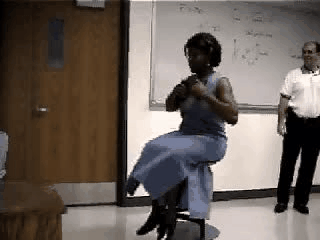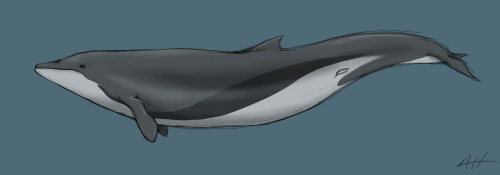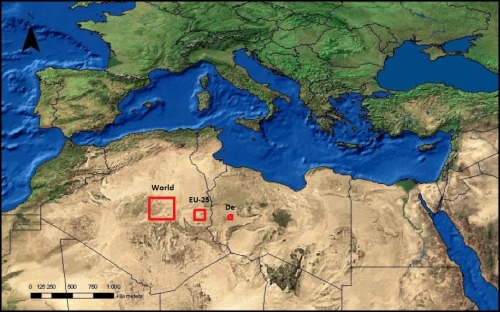Spin Stabilization

Yes, sure its fun to see a lady spin around like that, but I had one of my friends ask me - “Where do you even use this mate?”
Here’s one application that I know very well off.
Spin Stabilization
If you have ever seen a rocket launch, you might know that sometimes the rockets are given a spin while launching. This is known as spin stabilization.

Basically, the rotational inertia of the rotating body will stabilize the rocket against any disturbances and help maintain its intended heading.
The same principle is used in rifling of firearms as well. **

YoYo DeSpin
Okay, now there is the question how to “De-spin” the rocket:
Well, you do what the lady does: stretch out your arms and you will slow down !

The rocket has weights connected to a cable that stretch out and almost immediately the rocket slows down. This maneuver is known as the YoYo DeSpin. ( Damn good name ! )
All thanks to the conservation of angular momentum !
Have a good one !
* Another method to stabilization : 3-axis stabilization
** Bullets spin stabilization - post
** Source rocket launch video
More Posts from Saients and Others

NASA astronaut Peggy Whitson becomes first woman to command ISS twice
NASA astronaut Peggy Whitson achieved a new milestone at the International Space Station on Sunday, when she became the first woman to command the ISS twice.
Whitson is replacing astronaut Robert Shane Kimbrough, who will depart the space station Monday.
“Up here we don’t wear shoes, but Shane is leaving me some pretty big socks to fill,” Whitson said during a live broadcast as she assumed her new position. Read more. (4/9/2017 3:40 PM)

The origin of the universe was not by a singularity, since in a singularity, the laws of nature are not valid or do not exist,

hey guys!! it has been a while :’))
however, i have finished my first semester of chemistry (pre-ib) and i felt as if that i did pretty well in this subject even though i had minimal background knowledge on it. i initially struggled with the concepts we did, but after studying hard and trying my best i have gotten used to it and have been improving so here are my tips and tricks for chemistry!
please understand that i have not been through all the topics in chemistry, i have only learnt about atomic structure, periodicity and bonding so my links and tips may only help you for those topics but they should help with the other topics also. (this is most likely a general chemistry masterpost btw)
important study tips:
ask questions in class!!!!!! this is incredibly important, as also for every subject but if you don’t understand the concept you will struggle like how i did in the beginning :( if you are too shy to ask your question in front of the class, go up to the teacher when you have some time or even email them. even just ask your friends or classmates who may have a better understanding of the concept, it definitely helps having different explanations on the same topic, having different perspectives and all
find good resources, go through past tests, past exams and worksheets so that you can have good practice of what may come in your tests and exams. my teacher was very organised and had plenty of resources for me to use to revise and learn in my spare time out of class. it also gave me the experience of the ib tests and exams so i knew what was to come
as said in my maths masterpost, try teaching others when they need help (if you understand the topic and they don’t) because this really seems to help me when studying for tests, i helped my friend with her questions about atomic structure and found myself learning and revising at the same time because of this
repetition!!! you may not get it right the first time, or even the second, but after lots of tries and times you will get there!! trust me :’))
if you don’t have resources, go search for some. there are plenty of studyblrs who do chem as a subject and im sure they are more than happy to help you (me too but i haven’t through many of the topics lol) once you have been through all the past papers you own, go google for some, especially ib kids, theres some out there for you!
have a periodic table with you at all times when studying chem! its a bit obvious but you would most likely need it
apps + websites:
periodic table apps (there is loads on the app stores but here are some i found)
periodic table [ android | ios ] very indepth and informative (glad i just found this one, im downloading it rn)
periodic table (this one is different) [ android | ios ]
there is plenty, so find the app which suits you and your learning needs
molview (this website allows you to draw molecules!!)
ibchem.com for my fellow ib chem students, this website has notes and other resources to help you with your studies
2016 ib data booklet (there is probably going to be a 2017 one soon but anyways this will be useful
khan academy chemistry (honestly this website is a blessing to all students, so helpful !!!!)
sparknotes chem
other chemistry masterposts:
chemistry by @areistotle
ap chemistry by @etudiance
chemistry resource masterpost originally by @physicnerd
general chemistry masterpost by @ellielearnsthings
my other masterposts:
chinese masterpost
app masterpost
bullet journaling
maths masterpost
advice for new studyblrs
physics masterpost
i hope that these resources and tips will help you in your chemistry studies c:
studygram: acadehmic

As a paleo-artist, one of my biggest pet peeves are prehistoric whales reconstructed not as whales but as sinewy, snarling, shrink-wrapped marine reptiles. It’s just not a plausible reconstruction, even if it’s highly speculative, and it paints an incorrect image in the public eye. Granted, this is a struggle I’ve exlpored in all forms of paleo-art and reconstructive illustration. But the whales have really been getting to me recently.
Here are some recontructions of Basilosaurus, if you don’t know what I mean (one by Karen Carr, the other by an artist I could not determine):


These snakey, reptilious reconstructions may stem from the fact that Basilosaurus, one of the first early cetaceans to be found, was believed to be a reptile when first discovered (hence the name). Maybe we simply haven’t fully shaken that mindset.
But still! Even the damn Smithsonian, which has such a wonderful collection of ancient cetaceans, is at fault in this:

Don’t even get me started on their recently-closed dinosaur hall. Thank the lord they’re finally renovating that dated piece of crap.
I have struggled to find a way to reconstruct these animals so that they are just a little bit more believeable. Up top I’ve done a really really quick sketch of Dorudon. I tried to not only make its body more streamlined and whale-like (because Dorudon has a lovely, almost but not quite modern-looking skeleton), but I also tried to give it markings similar to what we find on modern cetaceans for camouflage. Because hey, who’s to say they didn’t have ‘em? I tried to make them familiar but not directly copied from any modern species.
Aaaaand end rant.
The Shepard-Risset Glissando
A Shepard tone, named after Roger Shepard, is a sound consisting of a superposition of sine waves separated by octaves. When played with the base pitch of the tone moving upward or downward, it is referred to as the Shepard scale. This creates the auditory illusion of a tone that continually ascends or descends in pitch, yet which ultimately seems to get no higher or lower. It has been described as a “sonic barber’s pole”.
Jean-Claude Risset subsequently created a version of the scale where the tones glide continuously, and it is appropriately called the continuous Risset scale or Shepard–Risset glissando. When done correctly, the tone appears to rise (or descend) continuously in pitch, yet return to its starting note. Basically, it’s a continuously descending tone that never gets any lower. It’s the acoustical version of M.C. Escher’s Penrose Stairs optical illusion. Source.
Doesn’t it sound a little bit creepy?

Spectacular collision of stars will create new star in night sky in 2022
1800 years ago two stars were coming together in a huge cataclysmic explosion. The light from that collision will finally arrive on Earth creating a new star in the night sky - dubbed the ‘Boom Star’ - in an incredibly rare event which is usually only spotted through telescopes. Before their meeting the two stars were too dim to be seen by the naked eye, but in 2022, the newly formed Red Nova will burn so brightly in the constellation Cygnus that everyone will be able to to see it. For around six months the Boom Star will be one of the brightest in the sky before gradually dimming, returning to its normal brightness after around two to three years. Read more

The total area of solar panels it would take to power the world, Europe, and Germany
23 science facts we didn't know at the start of 2016
1. Gravitational waves are real. More than 100 years after Einstein first predicted them, researchers finally detected the elusive ripples in space time this year. We’ve now seen three gravitational wave events in total.
2. Sloths almost die every time they poop, and it looks agonising.
3. It’s possible to live for more than a year without a heart in your body.
4. It’s also possible to live a normal life without 90 percent of your brain.
5. There are strange, metallic sounds coming from the Mariana trench, the deepest point on Earth’s surface. Scientists currently think the noise is a new kind of baleen whale call.
6. A revolutionary new type of nuclear fusion machine being trialled in Germany really works, and could be the key to clean, unlimited energy.
7. There’s an Earth-like planet just 4.2 light-years away in the Alpha Centauri star system - and scientists are already planning a mission to visit it.
8. Earth has a second mini-moon orbiting it, known as a ‘quasi-satellite’. It’s called 2016 HO3.
9. There might be a ninth planet in our Solar System (no, Pluto doesn’t count).
10. The first written record demonstrating the laws of friction has been hiding inside Leonardo da Vinci’s “irrelevant scribbles” for the past 500 years.
11. Zika virus can be spread sexually, and it really does cause microcephaly in babies.
12. Crows have big ears, and they’re kinda terrifying.
13. The largest known prime number is 274,207,281– 1, which is a ridiculous 22 million digits in length. It’s 5 million digits longer than the second largest prime.
14. The North Pole is slowly moving towards London, due to the planet’s shifting water content.
15. Earth lost enough sea ice this year to cover the entire land mass of India.
16. Artificial intelligence can beat humans at Go.
17. Tardigrades are so indestructible because they have an in-built toolkit to protect their DNA from damage. These tiny creatures can survive being frozen for decades, can bounce back from total desiccation, and can even handle the harsh radiation of space.
18. There are two liquid states of water.
19. Pear-shaped atomic nuclei exist, and they make time travel seem pretty damn impossible.
20. Dinosaurs had glorious tail feathers, and they were floppy.
21. One third of the planet can no longer see the Milky Way from where they live.
22. There’s a giant, 1.5-billion-cubic-metre (54-billion-cubic-foot) field of precious helium gas in Tanzania.
23. The ‘impossible’ EM Drive is the propulsion system that just won’t quit. NASA says it really does seem to produce thrust - but they still have no idea how. We’ll save that mystery for 2017.




Victoria LaBarre was climbing out of a canyon and into a bright, vast, seemingly lifeless landscape when she started to experience an astronaut’s nightmare.
“Suddenly,” she said, “I couldn’t breathe.”
The symptoms were real — maybe from claustrophobia, or from exertion at high altitude. But LaBarre didn’t unlatch her helmet to get a breath of fresh air because, in this simulated Mars exercise in the Utah desert, she was supposed to be an astronaut. The canyon was standing in for Candor Chasma, a 5-mile-deep gash in the Red Planet’s surface. On Mars, there’s no oxygen in the air — you do not take off your helmet.
So, instead, LaBarre radioed for help from fellow members of Crew 177. The team of students and teachers from a Texas community college had applied together to live and work for a week this spring in a two-story metal cylinder at the privately run Mars Desert Research Station near Hanksville, Utah.
Elijah Espinoza, a freshman assigned to be a crew engineer and geologist for the week, heard LaBarre’s call and walked her through some breathing exercises.
“I think that’s really one of the best things about Mars — the teamwork,” said LaBarre.“I don’t think you could live without it.”
To Prepare For Mars Settlement, Simulated Missions Explore Utah’s Desert
Photos: Rae Ellen Bichell/NPR
-
 litschilicia liked this · 4 years ago
litschilicia liked this · 4 years ago -
 swaytothemusic reblogged this · 4 years ago
swaytothemusic reblogged this · 4 years ago -
 swaytothemusic liked this · 4 years ago
swaytothemusic liked this · 4 years ago -
 junohnebula reblogged this · 5 years ago
junohnebula reblogged this · 5 years ago -
 junohnebula liked this · 5 years ago
junohnebula liked this · 5 years ago -
 cy-bern liked this · 5 years ago
cy-bern liked this · 5 years ago -
 kitypowaz liked this · 5 years ago
kitypowaz liked this · 5 years ago -
 megafab23 liked this · 5 years ago
megafab23 liked this · 5 years ago -
 dc-gay reblogged this · 5 years ago
dc-gay reblogged this · 5 years ago -
 dc-gay liked this · 5 years ago
dc-gay liked this · 5 years ago -
 cooltmoney95 liked this · 5 years ago
cooltmoney95 liked this · 5 years ago -
 harley-quinneth liked this · 5 years ago
harley-quinneth liked this · 5 years ago -
 goodenoughtolive reblogged this · 5 years ago
goodenoughtolive reblogged this · 5 years ago -
 goodenoughtolive liked this · 5 years ago
goodenoughtolive liked this · 5 years ago -
 pebblejrock reblogged this · 5 years ago
pebblejrock reblogged this · 5 years ago -
 primaryaccofhf liked this · 5 years ago
primaryaccofhf liked this · 5 years ago -
 crazypizzapersona liked this · 5 years ago
crazypizzapersona liked this · 5 years ago -
 mythicbitchx liked this · 5 years ago
mythicbitchx liked this · 5 years ago -
 raythegay512-blog liked this · 5 years ago
raythegay512-blog liked this · 5 years ago -
 baby-a-in-trenchcoat liked this · 5 years ago
baby-a-in-trenchcoat liked this · 5 years ago -
 megarambler liked this · 5 years ago
megarambler liked this · 5 years ago -
 randybacchus2u reblogged this · 5 years ago
randybacchus2u reblogged this · 5 years ago -
 randybacchus2u liked this · 5 years ago
randybacchus2u liked this · 5 years ago -
 curiosity-garden reblogged this · 5 years ago
curiosity-garden reblogged this · 5 years ago -
 spymasteroo13 liked this · 5 years ago
spymasteroo13 liked this · 5 years ago -
 alessandrajudithmireles-blog liked this · 5 years ago
alessandrajudithmireles-blog liked this · 5 years ago -
 alessandrajudithmireles-blog reblogged this · 5 years ago
alessandrajudithmireles-blog reblogged this · 5 years ago -
 bellany liked this · 5 years ago
bellany liked this · 5 years ago -
 chumanzky reblogged this · 5 years ago
chumanzky reblogged this · 5 years ago -
 chumanzky liked this · 5 years ago
chumanzky liked this · 5 years ago -
 myyearofstressandrelaxation liked this · 5 years ago
myyearofstressandrelaxation liked this · 5 years ago -
 wounderingjay reblogged this · 5 years ago
wounderingjay reblogged this · 5 years ago -
 wounderingjay liked this · 5 years ago
wounderingjay liked this · 5 years ago -
 siodymph reblogged this · 5 years ago
siodymph reblogged this · 5 years ago -
 siodymph liked this · 5 years ago
siodymph liked this · 5 years ago -
 spectacular-girl liked this · 5 years ago
spectacular-girl liked this · 5 years ago -
 wolf-said-what-now liked this · 5 years ago
wolf-said-what-now liked this · 5 years ago -
 kalybaly reblogged this · 5 years ago
kalybaly reblogged this · 5 years ago -
 kalybaly liked this · 5 years ago
kalybaly liked this · 5 years ago
Stardate: 2258.42...or, uh, 4... Whatever. Life is weird, at least we've got science.
75 posts
